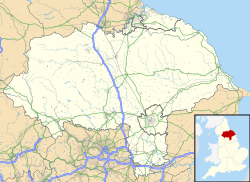Kirkby (historically known as Kirkby-in-Cleveland) is a village and civil parish in the county of North Yorkshire, England, near Great Busby and 2 miles (3.2 km) south of Stokesley.[2] The village is mentioned in the Domesday Book as belonging to Uhtred.[3] The name of the village derives from the Old Norse kirkju-býr, which means church with a village.[4] At the 2001 Census, the population of the village was recorded at 313,[5] dropping slightly to 309 at the 2011 Census.[1] In 2015, North Yorkshire County Council estimated the population to be 310.[6]
| Kirkby | |
|---|---|
 St Augustine's Church, Kirkby, in 2004 | |
Location within North Yorkshire | |
| Population | 309 (2011 census)[1] |
| OS grid reference | NZ538059 |
| Civil parish |
|
| Unitary authority | |
| Ceremonial county | |
| Region | |
| Country | England |
| Sovereign state | United Kingdom |
| Post town | MIDDLESBROUGH |
| Postcode district | TS9 |
| Police | North Yorkshire |
| Fire | North Yorkshire |
| Ambulance | Yorkshire |
From 1974 to 2023 it was part of the district of Hambleton, it is now administered by the unitary North Yorkshire Council.
The village used to be served by Stokesley railway station on the Picton to Battersby railway line, which was 1 mile (1.6 km) north of the village.[7] The A172 road is to the north and the B1257 Stokesley to Helmsley road is in the village of Great Broughton, 0.62 miles (1 km) to the east.[8]
St Augustine's Church, Kirkby was built in 1815 to replace a medieval building.[9] The chancel was rebuilt in the early 1900s by London architect Temple Moore. It is a grade II* listed building.[10] Besides the church, Kirkby also has a village hall and a public house, the Black Swan.[11]
To the south of the village is Kirby Bank (without a second 'K'). Part of the pathway there is a medieval greenway known as the Kirby Bank Trod, which is believed to have been laid in the 12th century as part of the route to Rievaulx Abbey. The track is a scheduled ancient monument.[12]
West of the village is Dromonby, the location of Dromonby Hall, a grade I listed 16th-century house.[13]
See also
editReferences
edit- ^ a b UK Census (2011). "Local Area Report – Kirkby Parish (1170216874)". Nomis. Office for National Statistics. Retrieved 29 April 2018.
- ^ "History of Kirby in Cleveland, in Hambleton and North Riding | Map and description". www.visionofbritain.org.uk. Retrieved 23 January 2020.
- ^ "Kirkby | Domesday Book". opendomesday.org. Retrieved 23 January 2020.
- ^ Ekwall, Eilert (1960). The concise Oxford dictionary of English place-names (4 ed.). Oxford: Oxford University Press. p. 279. ISBN 0-19-869103-3.
{{cite book}}: ISBN / Date incompatibility (help) - ^ UK Census (2001). "Local Area Report – Kirkby Parish (36UC085)". Nomis. Office for National Statistics. Retrieved 23 January 2020.
- ^ "2015 Population Estimates Parishes" (PDF). northyorks.gov.uk. December 2016. p. 11. Archived from the original (PDF) on 4 June 2022. Retrieved 23 January 2020.
- ^ "Parishes: Kirkby-in-Cleveland | British History Online". www.british-history.ac.uk. Retrieved 23 January 2020.
- ^ "OL26" (Map). North York Moors - Western area. 1:25,000. Explorer. Ordnance Survey. 2016. ISBN 9780319242650.
- ^ "Genuki: Kirkby In Cleveland, Yorkshire (North Riding)". www.genuki.org.uk. Retrieved 23 January 2020.
- ^ Historic England. "CHURCH OF ST AUGUSTINE (1189284)". National Heritage List for England. Retrieved 9 December 2013.
- ^ Barnett, Ben (29 September 2019). "Village Focus: Protecting the peace at Kirkby in Cleveland". The Yorkshire Post. Retrieved 23 January 2020.
- ^ Historic England. "Kirby Bank Trod, a section of paved trackway extending 400m southwards from just east of The Warren (1405913)". National Heritage List for England. Retrieved 23 January 2020.
- ^ Historic England. "Dromonby Hall and Dromonby Hall Cottage with attached outbuilding, Kirby (1151365)". National Heritage List for England. Retrieved 26 February 2025.
External links
editMedia related to Kirkby, North Yorkshire at Wikimedia Commons
